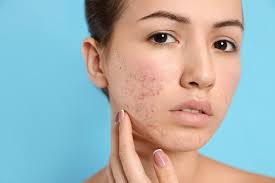Cystic acne is a dermatological disease characterized by painful and sometimes combined nodular-cystic formations under the skin. They represent the most severe variant of acne . The clinical picture is most striking, primarily in adolescence, but it may appear later.
What are the reasons? Cystic acne is a skin disease caused by chronic inflammation of the hair follicles and their corresponding sebaceous glands. What matters is the excessive activation of the glands in response to a neuroendocrine stimulus. By working harder than usual, the sebaceous glands produce more sebum. In this case, keratinization of the sebaceous ducts occurs, due to androgen hyperactivity .
Sebum mixed with keratinized cells accumulates in the follicle, creating a "plug" that does not allow the secret itself to flow out. This forms a comedo , which is the primary lesion of acne . Inflammation of closed comedones is manifested by a red, slightly raised papule, which may be superimposed by a pustule due to the multiplication of bacteria normally present in the skin ecosystem. The spread of the inflammatory process in depth causes the formation of nodules and cysts.
What are the risk factors for cystic acne? Many factors can contribute to the development of cystic acne . For example, adolescence. During puberty, increased androgen levels stimulate sebum production and hyperproliferation keratinocytes . Also, the hormonal changes that occur during pregnancy or during the menstrual cycle favor acne .
The risk of developing cystic acne occurs with cortisone and progestane therapy , as well as with antidepressants. The use of inappropriate, too oily or comedogenic cosmetics leads to the accumulation of sebum and blockage of hair follicles. Even too intensive and frequent washing can aggravate the situation. In adult women , bone acne is associated with polycystic ovaries. Cysts can increase androgen levels, which stimulate sebum production. Other conditions often associated with diseases are endometriosis and dysmenorrhea. To the cystic acne is predisposed by smoking, excessive sun exposure, and being overweight.
How is it manifested? Cystic acne is a painful, reddish-purple bump that may ooze a yellowish fluid. The size of the cysts ranges from a few millimeters to several centimeters. Often these manifestations are associated with burning, itching and pain when pressed. If the cystic foci are deep and chronic, the situation can become more complicated and dark spots and irreversible scars appear on the skin. Large cystic formations with suppurative and abscessing phenomena predominate on the back.
How to deal with cystic acne? To properly deal with cystic acne , when the first signs appear, it is advisable to consult a dermatologist. Treatment of cystic acne requires a targeted and individualized approach. If necessary, consultations of gynecologists and endocrinologists are appointed at the Bogolyuby Medical Center .
The goal of therapy is to prevent new lesions, reduce and eliminate existing skin rashes. Topical treatment includes the application of gels, solutions and lotions based on antiseptics or creams based on retinoids . In some cases, topical antibiotics and azelaic acid may be used. In the most severe cases, therapy involves the use of systemic drugs such as antibiotics, isotretinoin , estrogens, and antiandrogens .
Can it be prevented? Given that the exact causes of cystic acne has not yet been studied well enough, unfortunately, it is not possible to talk about prevention. However, some lifestyle changes help improve the situation and increase the effectiveness of the treatment proposed by the dermatologist. Don't pop pimples, don't use harsh, oily or comedogenic cosmetics, and eat a healthy diet.
















